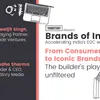How D2C brands should leverage technology to grow their business
Pepperfry CTO Sanjay Netrabile believes D2C brands should keep technology requirements as simple as possible, in tune with their business strategy.
The growth of direct to consumer (D2C) brands primarily rests on the technology stack that these companies deploy and a furniture marketplace like with a decade-long experience has simple advice to those building this infrastructure: keep it simple.
Speaking at the launch event of Brands of India, an initiative by YourStory, Sanjay Netrabile, CTO of Pepperfry, said, “Technology is an enabler of business and D2C brands need to understand problems they are facing and how tech can solve them.”
Founded in 2011, Pepperfry today has over 3.5 million active users, and boasts of five million visitors per month. The startup has undergone stages of steep learning, witnessing numerous technology cycles.
“Today, you have a lot of players who can help launch you in the market but the sweet spot is when you decide to pivot to your in-house team to build your own solutions. That is the critical point,” said Sanjay.
He added how Pepperfry built its own supply chain logistics solution to ensure better experience for the customers.
“There are a plethora of solutions but we need to take them and learn from them. There is no need to build everything in-house.”

He said that the technology roadmap for any D2C brand is closely matched with its business roadmap. Pepperfry started out by creating a monolithic structure but now has micro technology front ends for customers.
It is an omnichannel platform with both online and offline experiences.
“The way we built our technology helps our customers having an immersive experience,” said Sanjay.
Pepperfry is now deploying various new-age technologies, such as serverless architecture, machine learning, augmented reality, and virtual reality.
“We use AR a lot and are now looking at how we can use VR to create a furniture-less studio,” Sanjay said.
At the same time, he cautioned that D2C brands should keep a constant watch on the costs incurred in deploying the technology. “The sweet spot is not to overoptimise or underoptimise,” he remarked.
For D2C brands, it is always the question of how agile they can be with their technology and how fast can they scale it. And the market certainly has enough number of readily available solutions to choose from.
“If I was launching Pepperfry right now, I would have piggy backed on many of the available solutions, tweaking and optimising,” Sanjay said.
At the end, D2C brands constantly need to look at how they can keep their customers engaged and convert them faster.
As a parting advice to the D2C brands on how they can leverage technology, Sanjay said, “In some cases, old boring technology works, and in some cases, the cutting edge technology works but always ensure the system is stable.”
Brands of India is a YourStory initiative to catalyse the growth of India's D2C economy. The initiative will bring together D2C ecosystem stakeholders, including brand builders, D2C startups, investors, corporates, and policymakers, to discover, build and help daring entrepreneurs create an additional 500 Brands of India in the next three years.
To know more about this initiative and the D2C ecosystem, visit brandsofindia.yourstory.com
Edited by Saheli Sen Gupta









